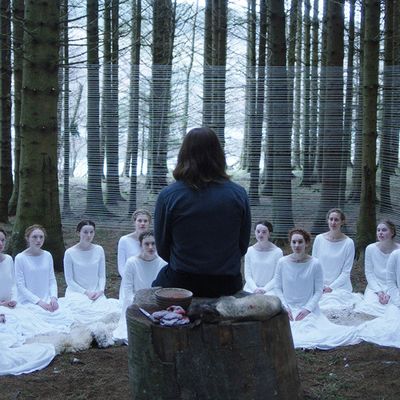
In the surreal subjugation film The Other Lamb, a Jesus-esque kind of guy who answers to the name “Shepherd” slowly walks around his circle of wives (they’ve just eaten and sung hymns of praise), squats beside one, and whispers, “Will you receive my grace?” The question is pro forma, actually. The chosen one will certainly receive Shepherd’s grace — i.e., his membrum virile — because that’s why she’s there. Day after day, she and her sister wives (dressed head to toe in red) compete for Shepherd’s attention. They drink in his sermons on the cruelty of the outside world; say, “Thank you, Shepherd, for allowing us to be your wives”; and tend to the blue-clad “daughters” who’ll one day — post-puberty but not too post — receive Shepherd’s grace for themselves. Shepherd is so full of grace that there’s no need for any other male on the premises. One daughter, Sela (Raffey Cassidy), quivering on the brink of womanhood, feels his eyes eating her up and has visions of birth, death, and menstruation — baby lambs denuded of flesh, birds secreting maggots, a ram with markedly horny horns. Sela sees herself underwater, clothes diaphanously swirling: Is she being reborn, as Shepherd has promised his cult? Or is she struggling to keep from being drowned?
Not much of a mystery, the nature of Shepherd’s divinity. So not-a-mystery it’s hard to imagine a large audience watching nearly two hours of Sela’s crisis of faith (Is Shepherd a good shepherd or a bad shepherd?) and not screaming: What’s wrong with you, woman??? But as luck would have it, you can’t see The Other Lamb with a large audience, not at this juncture. You have to fume alone or with someone who — no matter how much you love him or her — could very well bring about your death. It makes for a different viewing experience, I’ll say that. Stuff you might have once laughed off seems soul-shattering. Although The Other Lamb is heavy-handed in every conceivable way and a few ways you’d never have conceived of, it has a special resonance in the spring of 2020. Given all the godly males who’ve been steering their flocks toward certain doom, misandry is more than ever a survival instinct.
The movie is the English-language debut of the Polish director Malgorzata Szumowska, whose work is so powerfully dislocating that The Other Lamb seems less like a pale retread of The Handmaid’s Tale than a primordial dream play, set in an era before people could read or write. It took a while for me to figure out the time period. (It’s a surprise.) And where, I wondered, was this empty, near-Biblical landscape? At first, I thought Utah, then Wyoming, then Iceland — but it’s Ireland, drained of Hibernian romance by Michal Englert’s chill visual palette and a score of abrasive strings. The accents are American but subtly not, with traces of the British Isles and Europe. (Shepherd is played by the Dutch Michiel Huisman of Treme, Nashville, and Game of Thrones, and, like many of his countrymen, he sounds too American to be American.)
Dislocation, that’s the ticket. There’s no clear demarcation between the real and the surreal, so The Other Lamb might well be taking place inside Sela’s head as she waits for the arrival of her menses, her unconscious signaling the onset of enslavement rather than the first stirrings of adult freedom. In her mystical visions (or are they real?) she runs along a cliff with a red stain blooming on the lower half of her snow-white nightgown. She is now ripe for Shepherd but also soiled, given that he judges menstruating women “unclean” and remands them to a dark shack — both a mixed message and profoundly anti-nature. Shepherd melts out of the mist like a hybrid of Jesus, Rasputin, and Dracula, his silhouette evoking the Shroud of Turin. He is all engulfing males rolled into one.
The idea is that vulnerable women will give up their autonomy — their very identities — to such an entitled being, which I found a stretch but which certainly has historical precedents. It’s best to view The Other Lamb as a rite-of-passage fantasia with a gossamer heroine. Raffey Cassidy was dazzling in Brad Bird’s Tomorrowland and as a budding teenager in Yorgos Lanthimos’s The Killing of a Sacred Deer (two brilliantly accomplished god-awful movies). With her pale blue eyes and long neck, she can still manage to project — after a childhood onscreen — the rawness of someone never before photographed, her face evoking the quintessential teenage demeanor: superiority with glints of uncertainty. The movie is a parable for women who know it all in black-and-white but still dream in blood red.


